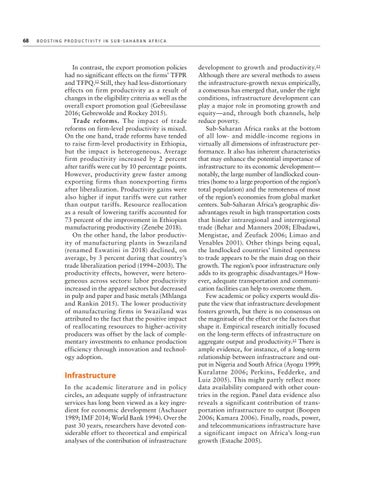68 B o o s t i n g
P r o d u c t i v i t y i n S u b - Sa h a r a n A f r i ca
In contrast, the export promotion policies had no significant effects on the firms’ TFPR and TFPQ.12 Still, they had less-distortionary effects on firm productivity as a result of changes in the eligibility criteria as well as the overall export promotion goal (Gebresilasse 2016; Gebrewolde and Rockey 2015). Trade reforms. The impact of trade reforms on firm-level productivity is mixed. On the one hand, trade reforms have tended to raise firm-level productivity in Ethiopia, but the impact is heterogeneous. Average firm productivity increased by 2 percent after tariffs were cut by 10 percentage points. However, productivity grew faster among exporting firms than nonexporting firms after liberalization. Productivity gains were also higher if input tariffs were cut rather than output tariffs. Resource reallocation as a result of lowering tariffs accounted for 73 percent of the improvement in Ethiopian manufacturing productivity (Zenebe 2018). On the other hand, the labor productivity of manufacturing plants in Swaziland (renamed Eswatini in 2018) declined, on average, by 3 percent during that country’s trade liberalization period (1994–2003). The productivity effects, however, were heterogeneous across sectors: labor productivity increased in the apparel sectors but decreased in pulp and paper and basic metals (Mhlanga and Rankin 2015). The lower productivity of manufacturing firms in Swaziland was attributed to the fact that the positive impact of reallocating resources to higher-activity producers was offset by the lack of complementary investments to enhance production efficiency through innovation and technology adoption.
Infrastructure In the academic literature and in policy circles, an adequate supply of infrastructure services has long been viewed as a key ingredient for economic development (Aschauer 1989; IMF 2014; World Bank 1994). Over the past 30 years, researchers have devoted considerable effort to theoretical and empirical analyses of the contribution of infrastructure
development to growth and productivity.13 Although there are several methods to assess the infrastructure-growth nexus empirically, a consensus has emerged that, under the right conditions, infrastructure development can play a major role in promoting growth and equity—and, through both channels, help reduce poverty. Sub-Saharan Africa ranks at the bottom of all low- and middle-income regions in virtually all dimensions of infrastructure performance. It also has inherent characteristics that may enhance the potential importance of infrastructure to its economic development— notably, the large number of landlocked countries (home to a large proportion of the region’s total population) and the remoteness of most of the region’s economies from global market centers. Sub-Saharan Africa’s geographic disadvantages result in high transportation costs that hinder intraregional and interregional trade (Behar and Manners 2008; Elbadawi, Mengistae, and Zeufack 2006; Limao and Venables 2001). Other things being equal, the landlocked countries’ limited openness to trade appears to be the main drag on their growth. The region’s poor infrastructure only adds to its geographic disadvantages.14 However, adequate transportation and communication facilities can help to overcome them. Few academic or policy experts would dispute the view that infrastructure development fosters growth, but there is no consensus on the magnitude of the effect or the factors that shape it. Empirical research initially focused on the long-term effects of infrastructure on aggregate output and productivity.15 There is ample evidence, for instance, of a long-term relationship between infrastructure and output in Nigeria and South Africa (Ayogu 1999; Kuralatne 2006; Perkins, Fedderke, and Luiz 2005). This might partly reflect more data availability compared with other countries in the region. Panel data evidence also reveals a significant contribution of transportation infrastructure to output (Boopen 2006; Kamara 2006). Finally, roads, power, and telecommunications infrastructure have a significant impact on Africa’s long-run growth (Estache 2005).



